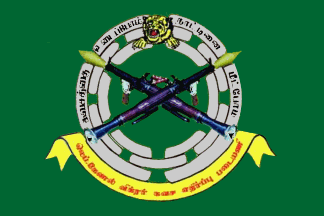


Īgainst the background of growing Sinhalese nationalism, which relied heavily on the symbolism of the Kandy Kingdom, the lion flag became the national emblem of the Sinhalese in the early 20th century. Although the lion was only one of the many regal insignia of the Kandy kings, the lion flag was interpreted by the British as the symbol of the kingdom they had conquered and was finally displayed as a trophy in the Royal Hospital Chelsea. After the conquest of Kandy, the British fell into their hands, along with other banners, a lion flag. The right part of today's flag with the golden lion goes back to a flag of the former Kingdom of Kandy, which existed until the annexation by the British in 1815. The lion is a symbol of the majority Sinhalese people, which derives its name from the Sanskrit word for "lion" ( singha ). The yellow frame that surrounds the flag and the stripes represent the unity of the country. The wine-red background represents Sinhalese, the majority of the country's inhabitants. The saffron-colored stripe stands for the Tamil ethnic group, the green for the Muslim inhabitants of Sri Lanka. In the left part of the flag two vertical stripes of equal size are placed, which are in the colors green (mast side) and saffron and represent the two large minority groups of the state. The lion stands for bravery, while the four leaves symbolize the four Buddhist " heavenly states of abode ", metta (goodness), karuna (compassion), mudita (compassionate joy) and upekkhā (equanimity). The golden leaf of a bodhi tree can be seen in each of the four corners of this part of the flag, the tips of which point towards the lion in the center. The national flag of Sri Lanka shows a golden lion against a claret background, which holds a sword ( kastane ) in its right front paw.


 0 kommentar(er)
0 kommentar(er)
